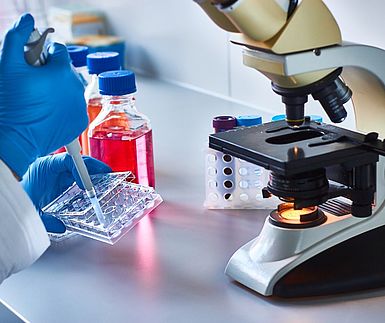Please type a search term (at least two characters)
News
Building up a metrology-based infrastructure for clinical measurands

Introducing the European Metrology Network for Traceability in Laboratory Medicine
Laboratory testing is at the heart of modern healthcare: an estimated 70% of medical decisions depend on in vitro diagnostics (IVDs). These are medical tests done on samples taken from the human body, such as blood and tissue. With the help of IVDs, there is a higher chance of detecting diseases and finding the right treatments. Unfortunately, 85% of lab tests currently used are not traceable. “Non-traceable tests have the inherent issue to deliver biased results,” says Rainer Stosch, acting chair of the Traceability in Laboratory Medicine network (TraceLabMed). “The validity of diagnosis can be enhanced by metrological traceability. Not only would patients benefit from more reliable diagnoses, but healthcare providers and the IVD industry would also have an advantage when using traceable IVDs.”
Laboratory medicine affects individuals from their early childhood right through to old age. As David Auerbach, coordinator of the network, points out “New-born babies are screened for inborn errors of metabolism with a blood test. If diseases, detected by IVDs, are left untreated they will have negative impacts on normal bodily functions.” Laboratory tests are also used when patients are required to take multiple medications, which is often the case for older patients, to understand whether the medicines will interact and cause side effects. Of course, in healthcare it is particularly crucial that investments are spent in most critical areas. “The available resources that can be devoted to establishing traceability for clinical measurands are limited. It is therefore important to prioritise and to distribute the workload efficiently to avoid any redundancies.” says David.

To meet this need, the European TraceLabMed network was established to build a coordinated metrology-based quality infrastructure in an area that affects almost every European citizen. David explains, “We will not only contribute by improving patient safety, but also by supporting the European IVD industry. One of our main aims is to connect with stakeholders to exchange information on needs and experiences about progress in metrology-based data assessment.” Rainer similarly views this as a vital element of the network, as research activities can have a much higher impact on society when stakeholder needs are the driving force. “We’ve initiated the network with the support of existing relationships to stakeholders. The EMN fosters top down research, which minimises the latency between getting scientific results and applying them. In addition, existing projects and services can be advertised via the network opening the possibilities of new business relations.” he says.
Within three years, Rainer is sure that the EMN will be recognised as sustainable, stakeholder-oriented focal-point, demonstrating its importance for European metrology and industry in the landscape of traceability for laboratory medicine.
Want to hear more about EURAMET?
Sign up for EURAMET newsletters and other information
Carbon dioxide, released from man-made activities, is lowering the pH of the Earth’s oceans, and impacting the health of marine organisms worldwide more
Supporting automated and reconfigurable manufacturing systems more
Working with external project Cool White to test and suggest improvements on the locally available white paints more
The project FutureEnergy has provided new calibration services for ultra-high voltages and a good practice guide on Lightning Impulse dividers more
For many of the 5000 photonics companies in Europe a precise knowledge of a material’s optical properties is vital for industrial competitiveness more





